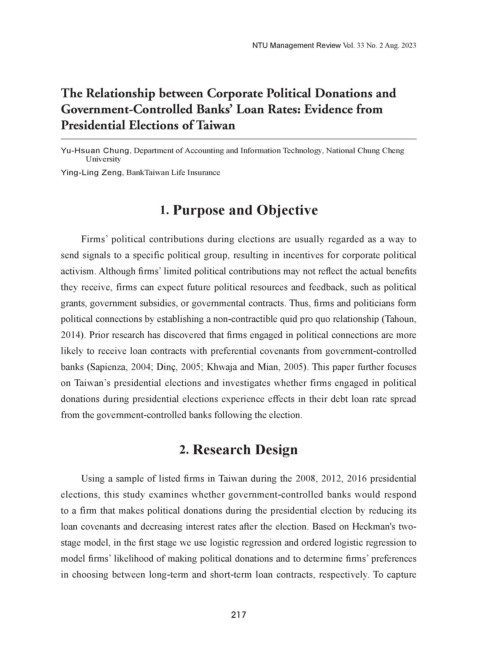Page 225 - 33-2
P. 225
NTU Management Review Vol. 33 No. 2 Aug. 2023
The Relationship between Corporate Political Donations and
Government-Controlled Banks’ Loan Rates: Evidence from
Presidential Elections of Taiwan
Yu-Hsuan Chung, Department of Accounting and Information Technology, National Chung Cheng
University
Ying-Ling Zeng, BankTaiwan Life Insurance
1. Purpose and Objective
Firms’ political contributions during elections are usually regarded as a way to
send signals to a specific political group, resulting in incentives for corporate political
activism. Although firms’ limited political contributions may not reflect the actual benefits
they receive, firms can expect future political resources and feedback, such as political
grants, government subsidies, or governmental contracts. Thus, firms and politicians form
political connections by establishing a non-contractible quid pro quo relationship (Tahoun,
2014). Prior research has discovered that firms engaged in political connections are more
likely to receive loan contracts with preferential covenants from government-controlled
banks (Sapienza, 2004; Dinç, 2005; Khwaja and Mian, 2005). This paper further focuses
on Taiwan’s presidential elections and investigates whether firms engaged in political
donations during presidential elections experience effects in their debt loan rate spread
from the government-controlled banks following the election.
2. Research Design
Using a sample of listed firms in Taiwan during the 2008, 2012, 2016 presidential
elections, this study examines whether government-controlled banks would respond
to a firm that makes political donations during the presidential election by reducing its
loan covenants and decreasing interest rates after the election. Based on Heckman's two-
stage model, in the first stage we use logistic regression and ordered logistic regression to
model firms’ likelihood of making political donations and to determine firms’ preferences
in choosing between long-term and short-term loan contracts, respectively. To capture
217

